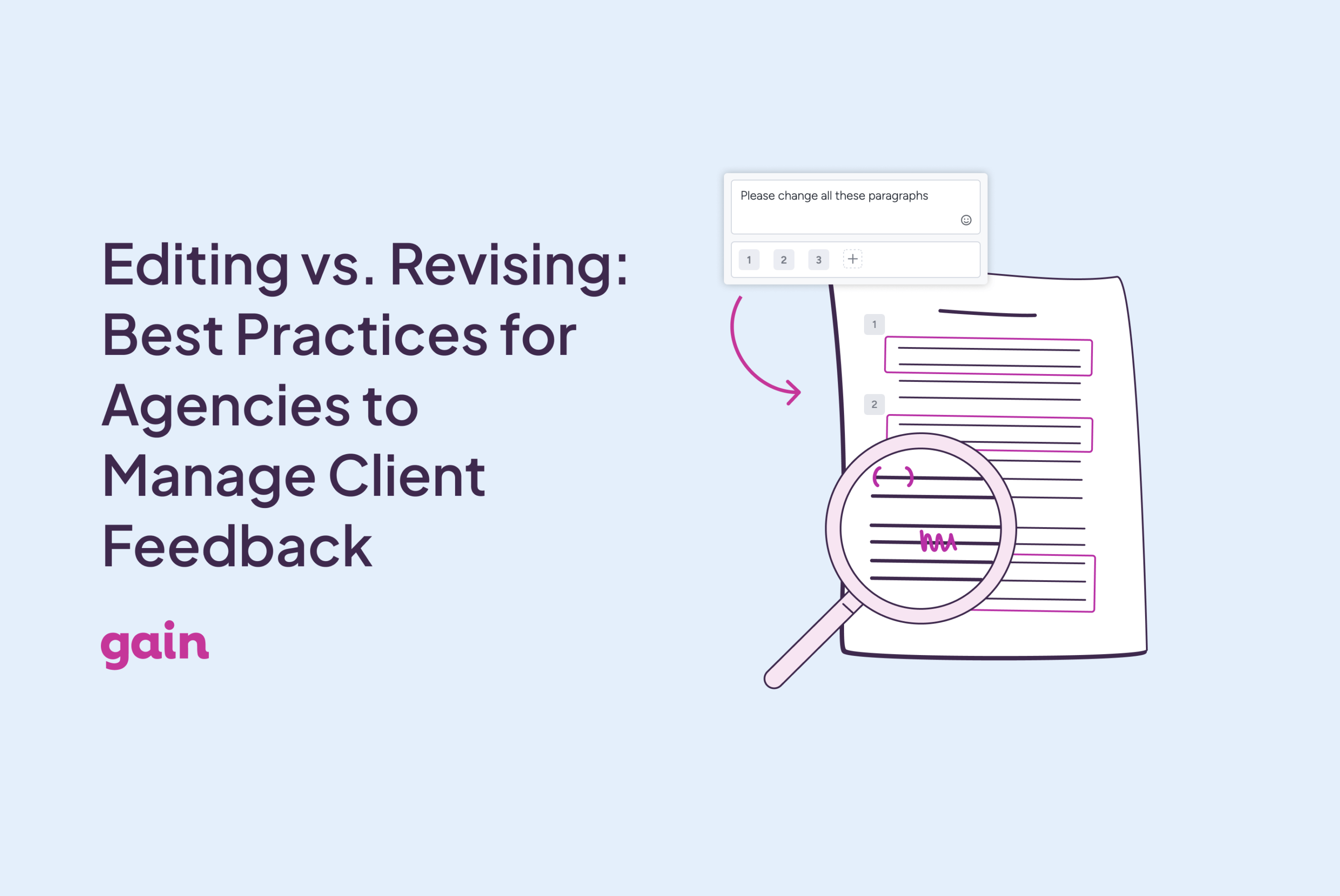Want to know more about editing vs. revising and managing client feedback? Check out our best practice guide to learn more.
Let’s face it: content is very rarely perfect the first time. As a social media marketing agency, you understand the collaborative process needed to make something good. Effective management of client feedback is crucial to producing the desired result.
When this process goes poorly, it can lead to a strained relationship between you and your clients. You need to do everything in your power to avoid getting to that uncomfortable stage.
When it comes to editing vs. revising, there are key differences to be aware of. Knowing the nuances of both will help you serve your clients more efficiently. This article aims to demystify those differences and offer best practices to help agencies navigate this process with ease.
Editing vs. Revising: What’s the Difference?
Editing
Editing involves making small changes to improve the quality of content. This means correcting grammar, formatting, or ensuring the brand voice is coherent. For example, you might adjust the tone of a LinkedIn post to better align with a client’s brand. This process is focused on polishing existing material rather than overhauling it.
📖 Related Read: What to Post on LinkedIn to Win More Business (9 Ideas + Tips)
Common editing requests include:
- Fixing typos.
- Enhancing clarity.
- Tweaking calls-to-action (CTAs) to make them more effective.
The goal is to refine the content so it is clear, consistent, and aligned with the client’s objectives without changing its overall structure or message.
Revising
Revising involves making deeper, more substantial changes to content. It focuses on strategy, messaging, and platform choices. It often requires repurposing content to better align with new goals that crop up along the content creation journey. For example, a client may decide mid-project that a LinkedIn post would be more effective than an Instagram carousel.
Typical revision requests include:
- Shifting the messaging to better resonate with a target audience.
- Reordering sections for better flow.
- Rewriting parts of the content to fit a new strategy or platform.
Essentially, revising transforms content to ensure it meets updated objectives and needs.
The Problem with Editing vs. Revising Requests
Editing and revising are part of the business. It’s normal to tweak pieces to keep the client happy.
Problems arise when they frequently ask for major revisions, which can be a sign of misaligned expectations. Friction occurs when clients can’t articulate what they want, or they’re constantly changing direction.
If you’re not careful, difficult clients can have you dealing with some serious scope creep. This can leave you feeling frustrated and miles away from what you originally agreed upon. To avoid these situations, you need best practices in place to help you manage your client feedback.
4 Best Practices for Managing Editing vs. Revising Requests
1. Set Clear Expectations in Contracts
Your best weapon for avoiding problems before they arise is your contract. Be as explicit as possible with your terms. Define what counts as editing and what constitutes revising so you always have a reference to return to.
You can include something like this:
“Editing includes grammar, spelling, and minor formatting adjustments. Revising includes strategic changes such as restructuring content, adjusting the platform, or reworking the message. Projects include up to two revision rounds; additional revisions may incur extra fees.”
You can also add a clause to limit revision rounds. Set a maximum of two or three revision rounds, and make it clear that you charge extra for additional revisions. It’s always best to be as explicit as possible upfront. Carefully managing expectations will pay dividends down the line.
2. Use a Social Media Content Approval Tool to Streamline Feedback
Although sending content back and forth for edits is pretty standard, it can become incredibly confusing. Without a pre-defined approval process, you can end up receiving feedback through various channels.
Trawling through your emails, Slack, and Google Docs for the correct versions can be frustrating and cause issues with version control.
Instead of juggling feedback across multiple platforms, use a dedicated social media management tool like Gain, which centralizes and automates the content approval process. Gain helps you:
- Set up automated approval workflows that move content through predefined review stages and from stakeholder to stakeholder, eliminating manual follow-ups.
- Provide clear, in-context feedback with comments and change requests right next to each social post—no more vague or misunderstood edits.
- Ensure faster approvals with a one-click approval system and automatic reminders to keep stakeholders on track.

By automating all of this heavy lifting, you can expect fewer revision requests and more organized workflows.
3. Set Time Limits for Feedback
Another best practice that we recommend is setting time limits for feedback. You can add a clause outlining your preferred timeframes in your contract. Something like: “All feedback must be submitted within [insert time frame] of receiving the draft”. You want to avoid the editing mistake of leaving everything to the last minute.
When you set an agreed-upon time frame, you reduce delays. This leads to happier clients and content that goes live on schedule. On top of that, you keep your fresh ideas from going stale. Don’t let your content wallow unexamined in inboxes. Insist on feedback, fast.
4. Do Internal Editing Before Submitting to Clients
While this may sound obvious, this tip is vital to save you time and protect your professional integrity. Poor spelling and grammar undermine all the work you put in. Cut the risk of your content being returned over silly errors by doing thorough agency-side checks. A standardized checklist can save you a lot of embarrassment over bad grammar and rounds of revisions.
We recommend that before your content reaches the client, you have:
- Checked for grammar & clarity.
- Ensured all content is aligned with the client’s brand voice.
- Incorporated strong messaging and calls-to-action (CTAs).
Make sure your checklist is shared with your whole team so everyone knows the standards you expect before content reaches clients. Quick edits are much less time-consuming for everyone involved when it comes to editing vs. revising.
Final Thoughts
Managing client feedback effectively is essential for delivering high-quality content that meets both client expectations and agency standards. Understanding the differences between editing vs. revising can streamline the process and avoid common pitfalls.
A clear client feedback game plan contributes to smoother workflows, better client relationships, and more consistent results. Using the right tool to take control of your feedback process and boost efficiency can help your content thrive.
Gain can save you time and take the stress out of the content approval process. Try Gain for free today and see for yourself how much faster your turnaround times can be with a solid content approval process in place for all your clients.






